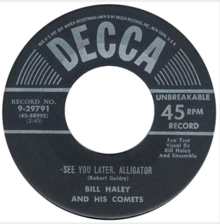Loading AI tools
1956 single by Bill Haley & His Comets From Wikipedia, the free encyclopedia
"See You Later, Alligator" is a 1950s rock and roll song written and first recorded by American singer-songwriter Bobby Charles. The song was a Top Ten hit for Bill Haley and His Comets in 1956 in the United States, reaching no. 6 on Billboard and CashBox. In the UK, the single peaked at no. 7.
| "See You Later, Alligator" | |
|---|---|
 | |
| Single by Bill Haley & His Comets | |
| Released | February 1, 1956 |
| Recorded | December 12, 1955 |
| Genre | Rock and roll |
| Length | 2:45 |
| Label | Decca Records |
| Songwriter(s) | Robert Guidry |
| Producer(s) | Milt Gabler |
Originally entitled "Later, Alligator", the song, based on a 12-bar blues chord structure (141541),[1] was written by Louisiana songwriter Robert Charles Guidry and first recorded by him under his professional name "Bobby Charles" in 1955. His recording was released on Chess Records under the title "Later, Alligator" as 1609 in November 1955 backed with "On Bended Knee". Guidry, a Cajun musician, adopted a New Orleans–influenced blues style for the recording. The melody of the song was borrowed from bluesman Guitar Slim's "Later for You, Baby" which was recorded in 1954.[2] Guidry also wrote "Walking to New Orleans", which was recorded by Fats Domino.
The song was also recorded by Roy Hall, who had written and recorded "Whole Lotta Shakin' Goin' On" ten weeks before, on December 1, 1955, at a Nashville session.
The most famous recording of the song,[3] however, was that created on December 12, 1955. by Bill Haley & His Comets at a recording session for Decca Records.[4] Unlike most of Haley's recordings for Decca, which were created at the Pythian Temple studio in New York City,[Note 1] "Alligator" and its flip-side, "The Paper Boy (On Main Street U.S.A.)", were recorded at the Decca Building in New York. The song was featured in Rock Around the Clock, a musical film Haley and the Comets began shooting in January 1956. Regarding the claim that Decca records released this disk on February 1, 1956, in both 45 and 78 formats,[5] Billboard had already listed the song as debuting on January 14, 1956, on the Best Sellers in Stores chart at no. 25 and on the Top 100 at no. 56.[6] The Decca single peaked at no. 6 on the Billboard and CashBox pop singles chart in 1956.[7]
Haley's arrangement of the song is faster-paced than Guidry's original, and in particular the addition of a two-four beat changed the song from a rhythm and blues "shuffle" to rock and roll. The song also has a more light-hearted beat than the original, starting out with a high-pitched, childlike voice (belonging to Haley's lead guitarist, Franny Beecher) reciting the title of the song. The ending of the song was virtually identical to the conclusion of Haley's earlier hit, "Shake, Rattle and Roll".
Bill Haley's recording of "See You Later, Alligator" popularized a catchphrase already in use at the time,[8] and Princess Margaret of the United Kingdom was quoted as saying it.[9][10] It would become Haley's third and final million-selling single, although it did not hit the top of the American charts.
Haley and the Comets re-recorded the song several more times: in 1964 for Guest Star Records, a drastically rearranged version for Mexico's Orfeon Records in 1966, and once more in 1968 for Sweden's Sonet Records. It was also a staple of the band's live act. Several post-Haley incarnations of The Comets have also recorded versions of the song. Guidry, under his Bobby Charles pseudonym, re-recorded the song in the 1990s.

Seamless Wikipedia browsing. On steroids.
Every time you click a link to Wikipedia, Wiktionary or Wikiquote in your browser's search results, it will show the modern Wikiwand interface.
Wikiwand extension is a five stars, simple, with minimum permission required to keep your browsing private, safe and transparent.